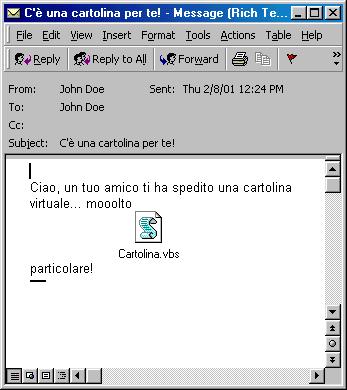Cartolina
Summary
Cartolina is a simple variant of the LoveLetter email worm.
This version has been written in Italy. It was found in the wild in early February, 2001. It's unlikely to spread far outside Italy.
Removal
Based on the settings of your F-Secure security product, it will either move the file to the quarantine where it cannot spread or cause harm, or remove it.
A False Positive is when a file is incorrectly detected as harmful, usually because its code or behavior resembles known harmful programs. A False Positive will usually be fixed in a subsequent database update without any action needed on your part. If you wish, you may also:
-
Check for the latest database updates
First check if your F-Secure security program is using the latest updates, then try scanning the file again.
-
Submit a sample
After checking, if you still believe the file is incorrectly detected, you can submit a sample of it for re-analysis.
Note: If the file was moved to quarantine, you need to collect the file from quarantine before you can submit it.
-
Exclude a file from further scanning
If you are certain that the file is safe and want to continue using it, you can exclude it from further scanning by the F-Secure security product.
Note: You need administrative rights to change the settings.
Technical Details
The attachment the worm sends around is called CARTOLINA.VBS, which means "Postcard" in Italian. The actual email message is Italian and reads:
From: name-of-the-infected-user To: random-name-from-outlook-address-book Subject: C' una cartolina per te! Attachment: CARTOLINA.VBS Ciao, un tuo amico ti ha spedito una cartolina virtuale... mooolto particolare!

The message means in english:
Subject: There's a postcard for you! Hi, a friend of yours has sent you a... veeeery peculiar virtual postcard!
The worm also changes the default start page of Internet Explorer to an Italian music web site.
After the worm send itself, it adds a registry key as a marker and does not spread from the same system again.